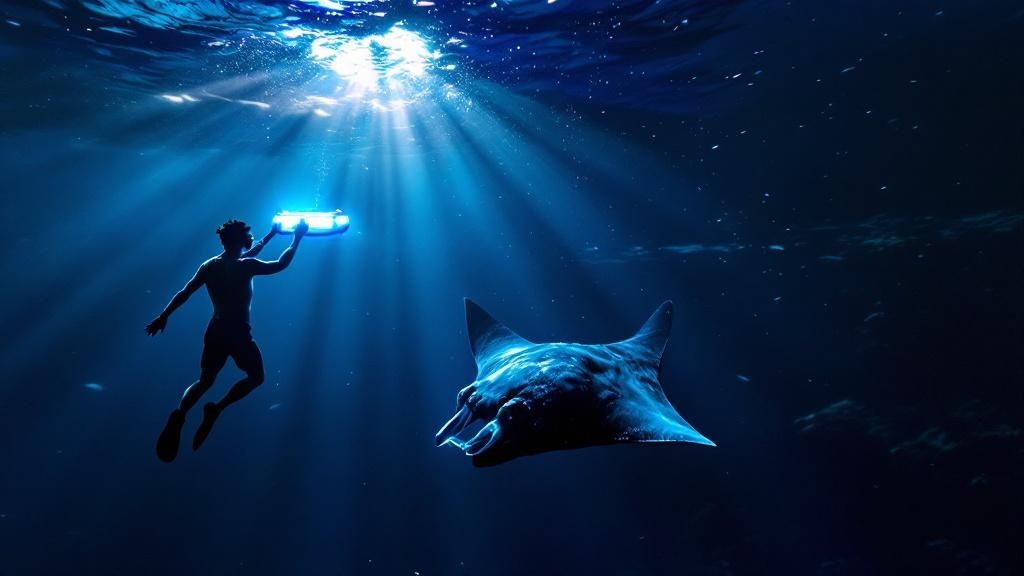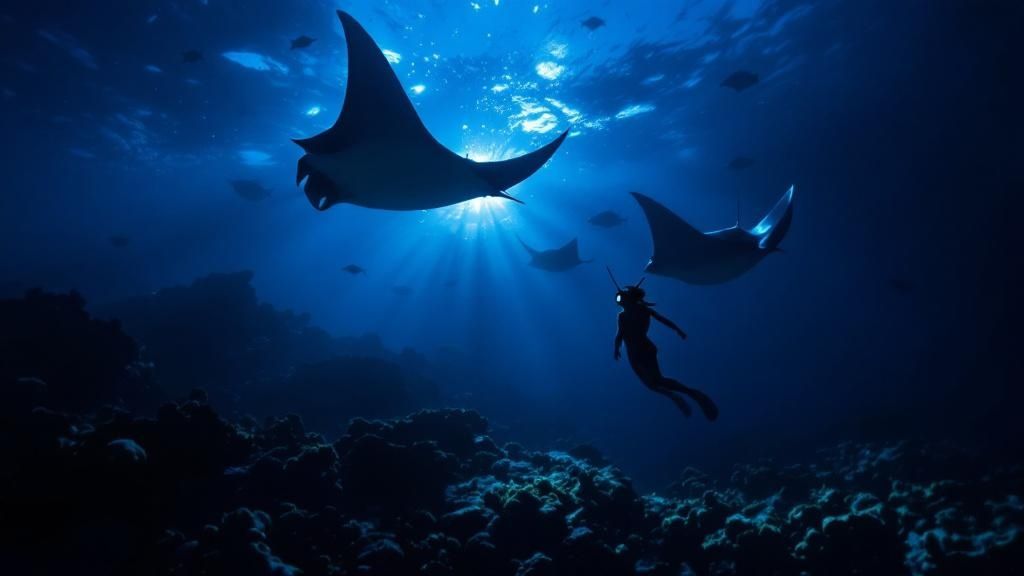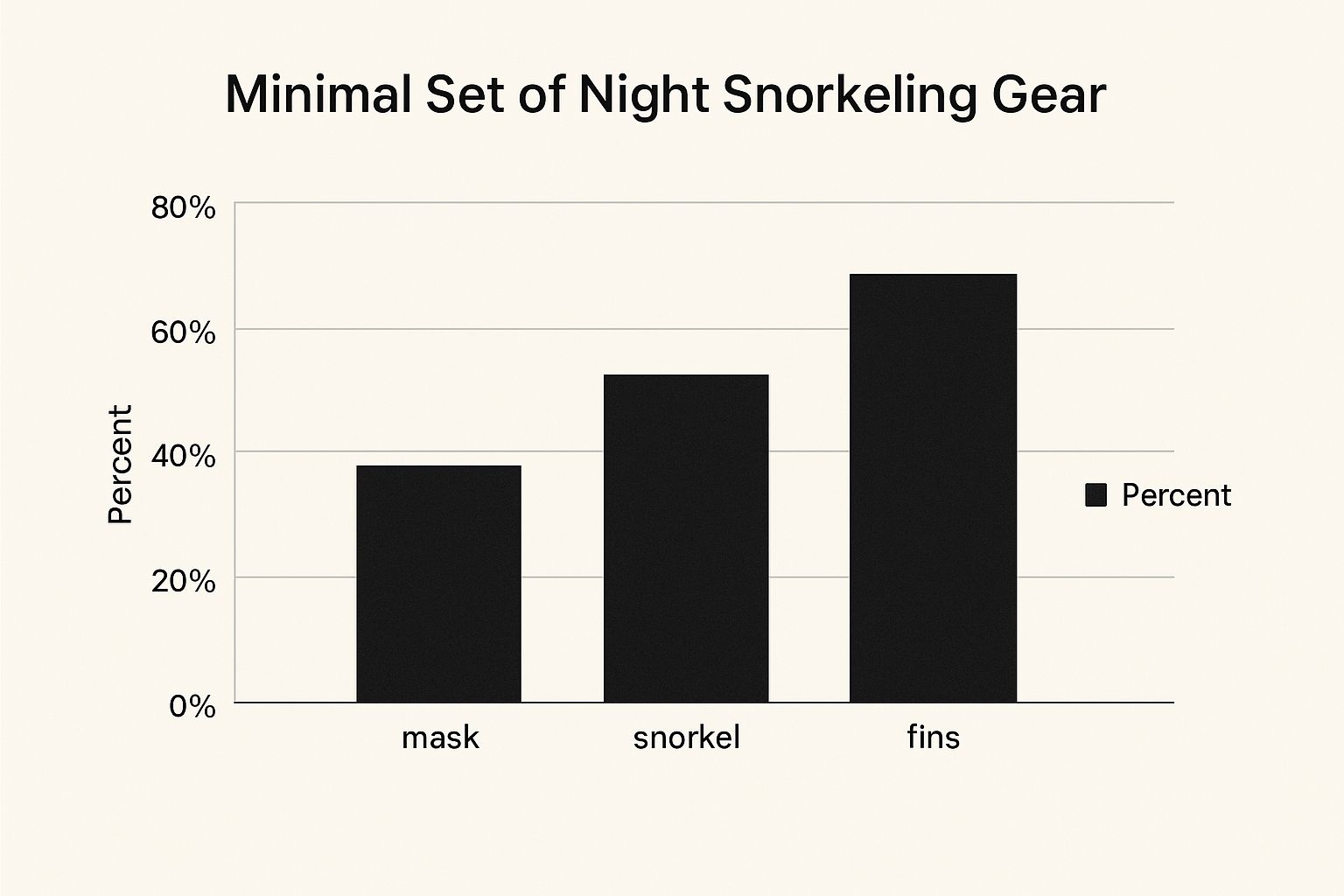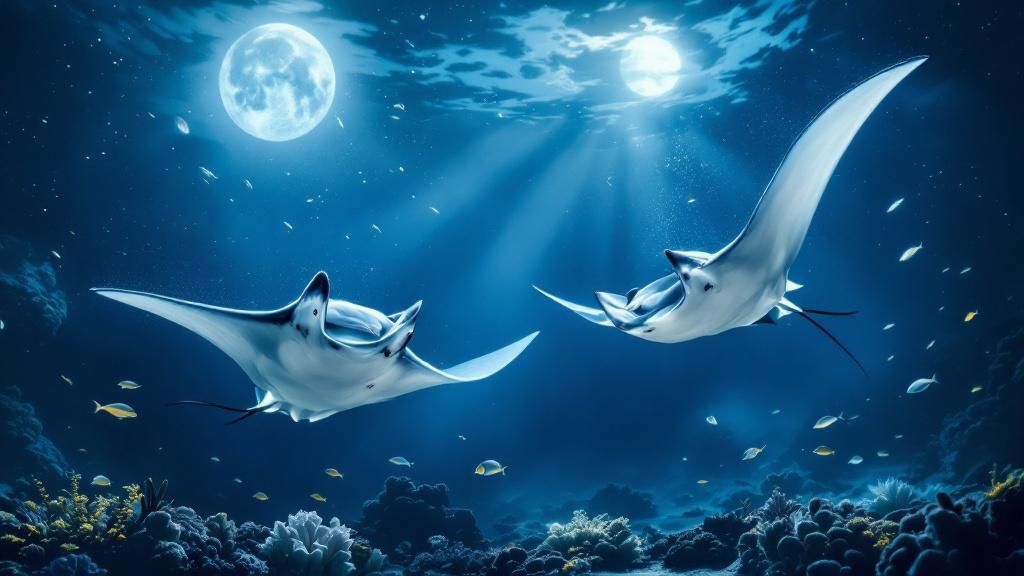Night Snorkel with Manta Rays Hawaii | Experience the Magic

Picture this: you’re floating on the dark, calm surface of the Pacific Ocean. Below you, huge, graceful manta rays glide effortlessly through the water, their cavernous mouths open to feed in the bright glow of underwater lights. This is the incredible, almost surreal experience of a night snorkel with manta rays hawaii—and this guide will walk you through exactly how to make this once-in-a-lifetime memory for yourself.
Your Guide to an Unforgettable Manta Ray Night Snorkel
This isn’t your average snorkeling trip. Think of it more like an underwater ballet, performed by some of the ocean’s most majestic animals. The Big Island's Kona Coast has, without a doubt, become the best place on Earth for this encounter, offering reliable, year-round sightings that feel completely out of this world.
So, what’s the secret behind this spectacle? And how can you be sure you're taking part in it safely and respectfully? We're here to give you all the details and the confidence you need to plan an adventure you’ll be talking about for years. We’ll get into why this experience is even possible, what makes it safe for total beginners, and how to be a good guest in the mantas' home.
A Thriving and Cherished Experience
Word has definitely gotten out about this unique adventure. The night snorkel with manta rays hawaii has become a signature Big Island activity, a shining example of how tourism can actually help conservation when it's done right. What was once a well-kept local secret has blossomed into a world-famous marine encounter.
This boom in popularity makes one thing crystal clear: choosing an ethical tour operator is essential. When you support a responsible company, you're directly funding the protection and study of Kona's resident manta population, helping to keep them healthy for generations to come.
The hype is well-deserved. It's estimated that a staggering 80,000 people now take part in this awe-inspiring activity every year. Major local resorts have even gotten involved, running their own nightly tours and setting up educational centers to teach visitors about the mantas and their conservation. It's a fantastic way to learn more about these gentle giants and the local efforts to protect them.
What This Guide Covers
We’ve packed this guide with everything you'll need to plan the perfect trip. Here’s a quick look at what we'll cover:
- How the encounter works: The simple science behind using light to attract the mantas' food source.
- Top locations: A head-to-head comparison of the two main snorkel sites on the Kona coast.
- Booking a tour: Tips for picking a safe, ethical, and top-rated operator for your adventure.
- Respectful interaction: The golden rules for snorkeling with mantas and ensuring a positive experience for both you and the rays.
How the Underwater Manta Ray Ballet Actually Works

So, how does this incredible spectacle happen night after night? The magic behind the night snorkel with manta rays in Hawaii is a wonderfully simple team-up between basic biology and a little bit of human ingenuity. It all starts with a concept anyone who’s sat near a porch light on a summer night gets right away.
When our tour boats get to the manta sites, we set up powerful, submerged lights. These lights cut through the dark ocean, creating a glowing beacon. This bright light acts like a giant, irresistible magnet for the ocean’s tiniest residents—plankton.
The Underwater Dinner Bell
These microscopic organisms are naturally drawn to the light, gathering in a thick, soupy cloud. It’s like an all-you-can-eat buffet suddenly appearing in the middle of the ocean. For manta rays, whose entire diet is plankton, this is a dinner bell they simply can't pass up.
Pulled in by this easy and reliable food source, the local manta rays show up for a feast. You get a front-row seat to their famous underwater acrobatics as they glide gracefully through the light beams, performing stunning barrel rolls to filter as much plankton-rich water as they can through their huge mouths.
It's a wild, yet wonderfully predictable, encounter. This choreographed feeding has become so dependable that it's now one of the most sought-after marine wildlife experiences on the planet.
The Specific Feeding Behaviors You'll Witness
Once you’re in the water, you're not just watching them swim around. These mantas are using specific, efficient techniques to eat, and you'll see it all up close.
- Barrel Rolls: This is the signature move. A manta ray will do a full somersault in the water, which lets it stay right in the thickest part of the plankton cloud for longer.
- Gliding Passes: You'll see mantas glide straight through the light with their mouths wide open, just gulping down massive amounts of water.
- Surface Feeding: Sometimes, the plankton is so dense near the surface that the mantas will skim just inches below you, their backs almost breaking the water's surface.
This isn't some show put on for tourists; it's a real feeding event. The mantas are there because it's a smart way for them to get a meal, and we're just incredibly lucky to be invited to watch. For more on what to expect, check out our ultimate guide to the Kona manta ray night snorkel.
Choosing Your Kona Manta Snorkel Location
If you're planning a night snorkel with manta rays on the Big Island, you’re heading to the Kona Coast. This is the place. You’ll have two main spots to choose from, and while both give you a fantastic shot at seeing these gentle giants, they offer a slightly different vibe. The best one for you really just boils down to where you're staying, your comfort level on a boat, and the kind of underwater backdrop you prefer.
The two go-to sites are known locally as Manta Village and Manta Heaven. I like to think of them as two different five-star restaurants that the mantas love to visit. Both serve up a delicious buffet of plankton, but the atmosphere and experience at each are unique.
Manta Village: The Classic and Convenient Choice
Just south of Kona town in Keauhou Bay, Manta Village is the original, legendary manta viewing site. It’s incredibly convenient. If you’re staying in or around Kailua-Kona, the boat ride is super short—sometimes just a few minutes from where you board. This is a massive advantage for anyone who gets seasick or for families snorkeling with younger kids.
The site is right offshore from a hotel that has had lights shining into the water for decades, attracting a reliable plankton supply. The consistency here is off the charts; some years, tour operators report successful manta sightings on over 95% of their trips. It’s a bit deeper, which can create a really dramatic show as the mantas glide up from the dark abyss into the bright lights.
Manta Heaven: A Remote and Sandy Stage
Head a bit further north, up near the Kona International Airport, and you'll find Manta Heaven. The boat ride to get here is longer, meaning more time out on the open ocean. But for many, the trip is well worth it for the unique experience this spot provides.
What really sets Manta Heaven apart is its shallower water and bright, sandy bottom. This sandy seafloor acts like a giant reflector for the tour lights, creating a brilliantly lit underwater stage. Many people feel the visibility is better here, and it makes for absolutely stunning photos and videos as the mantas soar over the illuminated sand.
Comparing Kona's Top Manta Ray Snorkel Sites
Still weighing your options? It can be a tough call. Both sites are world-class, but one might be a slightly better fit for your group. This table breaks down the key differences between Manta Village and Manta Heaven to help you lock in your decision.
| Feature | Manta Village (Keauhou Bay) | Manta Heaven (Makako Bay) |
|---|---|---|
| Location | Just south of Kailua-Kona | North of Kailua-Kona, near the airport |
| Boat Ride | Shorter (often 5-15 minutes) | Longer (can be 20-30+ minutes) |
| Best For | Families, those prone to seasickness, convenience | Adventurous snorkelers, photographers |
| Seafloor | Deeper, rocky reef | Shallower, sandy bottom |
| Ambiance | Dramatic ascents from the deep | Bright, amphitheater-like setting |
| Reliability | Extremely high and consistent | Very high, but can vary slightly more |
Ultimately, there's no "wrong" answer here. The choice between Manta Village and Manta Heaven simply comes down to tailoring the night to your personal style.
No matter which location you pick, your tour operator will outfit you with the right gear to keep you safe and comfortable. This is the essential kit that transforms a simple swim into an unforgettable underwater ballet.

The mask, snorkel, fins, and wetsuit are your ticket to the show, allowing you to float effortlessly while the mantas work their magic below.
How to Select a Safe and Ethical Tour Operator
Picking your tour operator for a night snorkel with manta rays in Hawaii is hands-down the most important decision you'll make. This choice doesn't just shape your own experience—it directly impacts the well-being of the gentle giants you’re so excited to see. When you go with a reputable, conservation-focused company, you're ensuring both your safety and the future of this incredible natural encounter.
Think of it like choosing a trusted guide for a mountain trek. You want someone with real-world experience, a rock-solid safety record, and a deep respect for the environment. Here in Kona, the best operators are the ones who voluntarily hold themselves to the highest standards of manta-safe tourism.
Look for Manta-Safe Practices
While the official "Manta Ray Green List" program isn't active anymore, its core principles are very much alive. The best companies continue to follow the established guidelines that put the mantas' safety above all else. These businesses are the true heart of responsible tourism on the Big Island.
Before you book, don't be shy about asking a few direct questions. A good operator will be proud to tell you about their safety protocols and conservation efforts.
- What is your guide-to-guest ratio? Smaller groups almost always mean a better, more personal, and safer time for everyone in the water.
- Are your guides lifeguard certified? This is a huge one. It’s a critical safety standard that proves your in-water guides are trained to handle any situation.
- What are your specific manta interaction rules? They should immediately bring up the strict "no touching" policy and explain the importance of being a passive, respectful observer.
Your financial support is a vote for the future of Kona's manta rays. By choosing an ethical operator, you're helping ensure these creatures are protected and that this magical experience will be available for many years to come.
What a Quality Tour Package Includes
A great tour is so much more than just a boat ride. A top-tier operator provides a complete package designed for your comfort, safety, and education, making sure you get the absolute most out of your adventure. Your tour fee should always cover high-quality gear that fits you properly, including wetsuits to keep you warm and well-maintained snorkel sets.
A thorough safety briefing is completely non-negotiable. This isn't just about how to use your gear; it needs to cover the specific rules for how to behave in the water around the mantas. It's also vital to understand all the physical and age-related considerations. For a detailed breakdown, you should review the official Kona manta ray night snorkel requirements before you book. This helps make sure everyone is fully prepared for a safe and amazing time.
What to Expect During Your Manta Ray Snorkel

Feeling a few butterflies about snorkeling in the dark? That’s totally normal. But once you know exactly what the trip entails from start to finish, I promise those nerves will turn into pure excitement. The whole night snorkel with manta rays in Hawaii is designed to be safe, comfortable, and absolutely mind-blowing, even if you’ve never put on a snorkel mask before.
Your adventure kicks off at the harbor, where you’ll meet the boat crew. After a warm aloha and a quick check-in, they’ll run through a detailed safety briefing. This isn’t just about how to wear your mask; they’ll cover the "rules of the road" for being in the water with mantas, which is all about keeping both you and these gentle giants safe.
Getting Geared Up and Into the Water
Once the boat is underway and heading to the site, the crew will get you kitted out with all the gear. You don't need to stress about bringing your own stuff, as a quality tour operator provides everything you'll need.
Your tour operator will provide:
- A wetsuit top: Hawaiian waters are warm, but you'd be surprised how chilly you can get just floating on the surface for a while. The wetsuit keeps you comfortable so you can just soak in the experience.
- Snorkel mask and fins: The crew are pros at making sure your mask has a good seal to prevent any annoying leaks.
- Flotation devices: If you want a little extra support, they’ll have things like pool noodles to help you relax.
After a short and scenic boat ride, you'll arrive at what we call the "manta campfire." Your guides will help you slip into the dark water, which is usually surprisingly calm and inviting. From there, it's just a short swim over to a big, custom-built floatation board. This board is the key—it has powerful lights that shine straight down, creating a glowing stage that attracts the plankton and, in turn, the mantas.
The single most important thing to remember is to stay horizontal on the surface, holding onto the raft. By just floating passively, you become part of the scenery. This allows the mantas to glide gracefully right underneath you without feeling crowded or threatened.
The Main Event
Your in-water guides are lifeguard-certified pros who are with you in the water the entire time, making sure everyone is safe and having a great time. Think of them as your personal narrators for the night; they'll often point out individual mantas they recognize by name and share amazing facts about their behavior as it happens.
As you float, mantas will swoop and barrel-roll, sometimes just inches below you, as they feed on the plankton drawn to the light. It's a completely silent, breathtaking ballet that unfolds right before your eyes. You’ll spend about 30-45 minutes in the water before your guide leads everyone back to the boat.
Make sure you have a towel and a change of clothes ready for the ride back to shore. You’ll be buzzing with excitement from the incredible encounter you just had
The Golden Rules of Respectful Manta Encounters
When you slip into the dark ocean for a night snorkel with manta rays in Hawaii, you’re stepping into their world. Think of yourself as a guest in their grand, underwater dining room. Just like you’d be a polite visitor in someone’s home, it’s our job to be respectful observers and make sure our presence doesn't disturb these magnificent creatures. Following a few simple guidelines is key to a safe and sustainable interaction for everyone.
The number one, non-negotiable rule is to never, ever touch a manta ray. It's so important it bears repeating. Mantas are covered in a thin, protective mucous layer—it’s like a slime shield that guards them against nasty bacteria and skin infections. Touching them, even by accident, can strip away this crucial coating, leaving them vulnerable to disease. Giving them space is the best way to keep them safe.
Be a Passive Observer
The best way to enjoy this incredible show is to simply float and watch. The tour provides a large, lighted raft for a reason: it keeps you stationary and on the surface. By just hanging out, you become part of the scenery. This allows the mantas to swim and feed naturally, and they'll often come within inches of you completely on their own terms.
To make sure the mantas feel comfortable, just keep these core principles in mind:
- Stay Horizontal: Keep your body flat on the water's surface. Dangling your legs down can get in their way as they glide underneath you.
- No Sudden Movements: Try to avoid splashing or kicking. Quick, jerky movements can startle the mantas and disrupt their feeding.
- Don't Dive Down: Snorkelers must stay at the surface. Diving down to get a closer look can mess up their feeding patterns and is prohibited by all responsible tour operators.
- Never Chase: Let the mantas come to you. Chasing after them only causes stress and can drive them away from the light source, ending the show for everyone.
By following these simple rules, you become a partner in conservation. Your mindful behavior helps ensure that this amazing natural encounter can continue to thrive for generations of visitors and mantas alike.
Understanding manta behavior is a huge part of these conservation efforts. For instance, detailed records kept from 2009 to 2014 along the Kona Coast gave us incredible insights into their movement and population patterns, helping tour operators and scientists figure out how to better protect them. You can discover more about these manta ray findings to see just how much data helps in their conservation.
And don't worry, these gentle giants are completely harmless to people. While they are related to stingrays, manta rays have no stinger, no barb, and no teeth. To ease any concerns you might have, our guide explains in detail why you can feel completely safe and answers the question: can manta rays sting you?.
Common Questions About the Manta Snorkel
As you get closer to your trip, a few final questions always seem to pop up. It's totally normal. You’re about to float in the dark ocean with giant sea creatures, after all! We've heard them all over the years, so we’ve put together the most common ones to set your mind at ease.
One of the biggest concerns we hear is about safety, especially for kids or folks who aren't confident swimmers. People wonder if they need to be an expert snorkeler. The answer is a definite no. You aren't swimming freely out in the open ocean; you'll be holding onto a large, custom-built floatation board with bright lights. It’s a very passive, relaxing experience, which makes it perfect for almost every age and swimming ability.
What if I Get Cold?
This is a really good question, especially since you'll be in the water at night. All the reputable tour companies provide high-quality wetsuit tops, and you’ll be surprised at how well they keep your core warm. Hawaiian waters are pretty comfortable all year, usually hovering around 75-80°F (24-27°C), but that wetsuit makes all the difference. It lets you just relax and be completely mesmerized by the manta ballet below.
Is There a Best Time of Year to Go?
Nope! And that’s one of the most amazing things about the Kona manta ray experience. The mantas here are a resident population, which just means they live here and don’t migrate. They show up for their plankton buffet almost every single night, year-round. Your shot at an incredible encounter is just as good in December as it is in July.
The most important timing detail isn't the season, but when you book the tour during your vacation. It's always a smart move to schedule your manta snorkel for one of your first nights on the Big Island.
What Happens if the Mantas Don't Show Up?
While sightings are incredibly consistent—most top operators have a success rate well over 90%—these are wild animals, and nature is never a 100% guarantee. On the rare night the mantas decide to skip dinner, most companies have a great policy. They'll typically offer to take you out again on another night for free. This is exactly why booking early in your trip is so crucial; it gives you the flexibility to reschedule if you happen to hit that unlucky night.
Ready to witness the underwater ballet for yourself? Kona Snorkel Trips offers Hawaii's highest-rated manta ray night snorkel, with lifeguard-certified guides and small-group tours that guarantee a safe and unforgettable experience. Book your adventure with us today!
